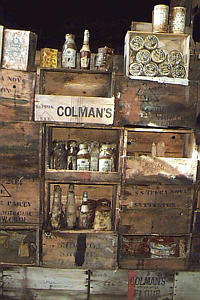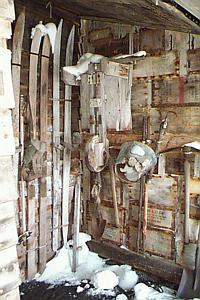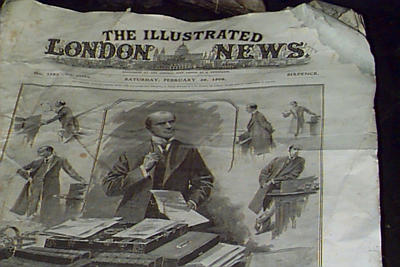16 November, 1998
November 16, 1998
Monday mornin' blues! This is such an odd feeling for me since I never
have them as a teacher. I love being a teacher! I guess I'm pretty
spoiled; how many people can truly say they love their jobs every day?
However this is great too. I'm learning a lot, I'm experiencing some
amazing things and savoring some awesomely spectacular scenery, I'm
meeting and working with some really excellent and interesting people,
and my work may be uncovering something new for science. Thinking
about all this pulls me out of my blues and focuses me on what I need
to do. The view outside the window, even on this gray overcast day
where the soothing, open expanse of ice and clouds seems to go on
forever, helps too.
CAPE EVANS, THE CAPE ROBERTS PROJECT
Yesterday we went fishing again at the fish hut at Cape Evans.
Another TEA teacher (Betty Trummel) and her PI (Dr. Ken Verosub) came
along with us. Ken and I drove out in the spryte. It was hot so we
popped open the hatches in the roof. Ken often stood up in the cab
and stuck his head out the top to take photos as we rumbled along. (I
did the same on the way back as Sierra drove.) The others rode
skidoos. Betty teaches 4th grade in Illinois and is an enthusiastic
wonderful person. You should read her excellent journal and look at
her digital photos too. Ken and Betty are working with the Cape
Roberts project. This project is drilling a hole from a platform on
the temporary sea ice into the rock at the bottom of the ocean to pull
out rock samples called cores. They have already drilled several
hundred meters. Experts will analyze the rocks to find out about the
past history of the Earth. The deeper samples of rock represent
sediments laid down further back in time than the more recent higher
up samples. They have dug down about 25 million years so far. This
project is amazing because it is an international and
interdisciplinary project. New Zealand, USA, Italy, England, and other
countries have all sent experts to contribute to the project. The
scientists are specialists in all kinds of things: volcanoes, diatoms,
foraminiferans, Earth's magnetism, sediments, and other seemingly
obscure and insignificant topics. Yet it is their expertise that is
teaching the world about its past climatological and geological
history. From the kinds of fossilized microscopic diatoms and
foraminferans found in these rocks (which formed from sediments in the
bottom of the ocean) they can determine what the climate was like at
any given time. From the shifts in magnetic fields that Dr. Verosub's
team measures in the sediments they can determine the age of the rock
at the depth of those fossils. The age of volcanic ash deposits can
also be determined using radiometric dating techniques to provide
corroborating evidence. Sediment types tell what the nearby land was
like. All of these scientists collaborate and share their information
in regular meetings. It is wonderful to see interdisciplinary science
in action! (Today I visited the core room and the lab that measures
the direction and miniscule amounts of mangetism in the samples. In
the core room the most recent core samples were laid out on the table
and about a dozen scientists were scattered all along them (about 10
meters of core)marking sections that they wanted to study in more
depth. Later that day, small samples (about an inch long and 3/4 inch
wide)were removed from the cores and delivered to their respective
labs here at Crary.)
SCOTTS HUT
Cape Evans is the site of research and exploration from which Captain
Scott launched an attempt to be the first team to reach the South
Pole. He had scientists based there with him who studied the climate,
geology, and biology of the area. They all lived in one wooden
building which served as dorm, kitchen, lab, study, and rec room.
Attached to the building were enclosed stables for the Siberian horses
they used to pull around a lot of the gear. They also had many dogs
for the same purpose. But on their trip to the Pole the people also
pulled sleds full of gear and food. Scott and his 4 British crew made
it to the pole but they had been beaten in the race by Amundsen and
his Norwegian team who took a different route and got there 2 weeks
earlier. On the way back, a storm trapped Scott and his team. Just 30
(or so) miles from a food supply they died.
The hut still looks much as it did when the rest of Scott's team
left the Antarctic. Like Shackleton's hut which I described in my
journal a couple weeks ago you could see food supplies, sleeping beags
and beds, a lab, shelves full of medicines, an old newspaper (1908),
books, and all the paraphernalia to live and do research in such a
forbidding place. I have attached some photos to give you an idea of
what it looked like.
On Sunday night I watched a 1913 black-and-white movie called 90
degrees South. It was filmed by one of Scott's crew that stayed behind
at Cape Evans and it documents what life was like. Tonight I will
watch another black-and-white film from 1918 (I think)documenting
Shackleton's failed attempt to reach Antarctica and traverse the
entire continent which is one-and-a-half times the size of USA.
Shackleton's ship, the Endurance, froze into the ice before they even
reached the continent. The pressures of the ice broke and sank the
ship stranding him and his men and dogs for months. The book
"Endurance" is great reading! I read it in 7th grade and remember it
to this day.
IT'S A SMALL WORLD
Yesterday I had two "it's a small world" experiences. I saw the
brother of one of my best friends from college (my roomate) whom I
hadn't seen for nearly 20 years (at his brother's wedding in Norway).
He is flying planes here. I also met the brother of a former fellow
teacher from Flint Hill and St. Stephen's School (Bill Dunbar's
brother Steve). He runs the Field Safety training program and is
involved with search and rescue missions here. Gee, it's a small world!
DASPEI
The increase in DASPEI dosage has worked. I have now used it in
3 fishes (2 warm and 1 cold) and the chloride cells were very visible
and photographable in all cases. I haven't counted and measured the
cells from the photographs yet but I will let you know what I find
out. One interesting thing that I've noticed is that so far the cold
fish (the ones living at their normal temperature of -1.86 degrees
Celsius) don't have as many parasites as what I saw in the gills of
the warmer fish (living at 4 degrees C).
HAPPY POLAR SCIENCE WEEK TO THE FLINT HILL LOWER SCHOOL!!! PLEASE LET
ME KNOW IF THERE IS ANYTHING I CAN DO HERE TO HELP YOUR WEEK BE A
SUCCESS. THANK YOU VERY MUCH FOR THE INTEREST YOU HAVE SHOWN IN MY
WORK AND FOR YOUR E-MAILS AND SUPPORT!!!!!
I hope you have a good day and do something good for someone.
Fred Atwood
_________________________________________________________
DO YOU YAHOO!?
Get your free @yahoo.com address at http://mail.yahoo.com

The lab in Scott's Hut.

A nice warm sleeping bag on a bed in Scott's Hut.

Some of the food enjoyed by Scott's crew.

More food. Notice the ketchup bottle on top and how they used the shipping boxes for shelves.

The entryway to Scott's hut.

Strips of seal blubber used to heat the hut. They even ate seal blubber at times.

Mr. Atwood is fascinated by the stuffed Emperor Penguin left behind by Scott's friend and ornithologist Dr. Wilson. He hopes this is not the only Emperor Penguin he will see.

A London newspaper from 1908 at the reading table next to the window in Scott's Hut.
Contact the TEA in the field at
.
If you cannot connect through your browser, copy the
TEA's e-mail address in the "To:" line of
your favorite e-mail package.
|
